The Nile river and its influence on settlement
The spread of Egypt’s knowledge
Together we will learn about the way of life in ancient Egyptian society. The development of the Egyptian civilization is traced from the beginning of the settlement at the Nile river through to the uniting of Upper and Lower Egypt under one Pharaoh.
We learn about their beliefs and religion and the important structures that still stand in Egypt today. We also outline the contribution that ancient Egyptians have made to the development of writing, mathematics and medicine. The mysteries of the tomb of Tutankhamen is also discussed in this topic.
The Nile river and its influence on settlement ↵
‘Not only is the Egyptian climate peculiar to that country, and the Nile different in the way it behaves from rivers elsewhere, but the manners and customs of the Egyptians themselves seem to be the opposite of the typical practices of mankind’. - Herodotus.
When Herodotus, the ancient Greek historian, wrote these words, Egyptian civilization had been going successfully for thousands of years without foreign interference. These unusual people, thanks to the uniquely protective Nile River Valley, had the opportunity to develop differently from Europe and the East. Long periods of isolated growth without foreign invasion occurred because Egypt had natural borders that were impossible, or very difficult to cross.
So immense is the significance of the Nile River to the development of Egyptian civilization, that we cannot separate the history of Egypt from its geography and other natural aspects. The Nile was very important as a communication and trade route across a vast and harsh land. Also, its annual flooding renewed farmlands that would otherwise be arid desert.
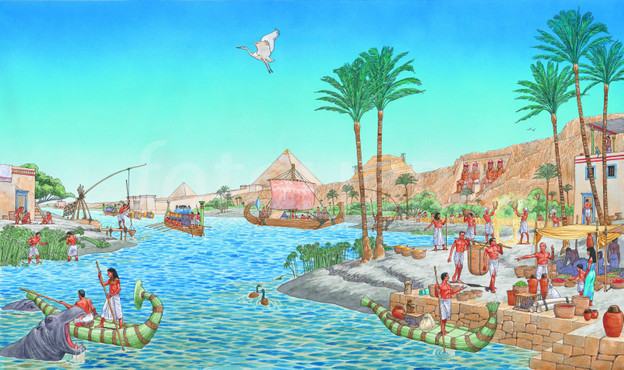
Outside of the Egyptian border the Nile divides into two main rivers, known as the White Nile and the Blue Nile. The White Nile is the longer of the two, and is responsible for 16 % of the water flow in the Nile River, which makes the Blue Nile the main source of water and also fertile soil to Egypt. The White Nile travels from Tanzania, through Uganda into Southern Sudan. The Blue Nile flows through Ethiopia and mergers with the White Nile near the Sudanese capital of Khartoum, becoming what is known as the Nile proper.
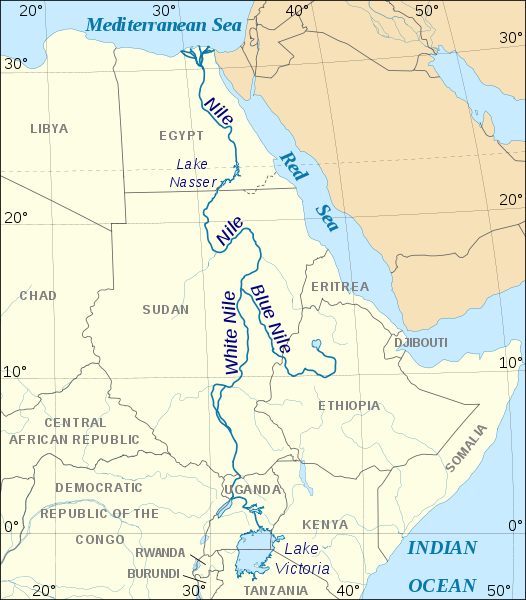 Map of the Nile River Image source
Map of the Nile River Image source
Since before written history, people have built their homes in towns and cities made along the banks of the Nile, but it wasn't always this way. The earliest inhabitants of this region were Stone-Age hunter-gatherers who roamed an immense area rich in wildlife, which is now a desert. With radical changes in climate, these people gradually replaced their nomadic culture with the settled life of agriculturalists.
‘We are content with our Black land ”¦ the heartland is with us’.
- A Pharaoh's inscription on a wall in the Temple of Karnak in Thebes, referring to Egyptian appreciation of the fertile soil.
The Sahara desert, the Nile River and the abundance of rock greatly influenced where and how the ancient Egyptians settled and built their civilization. These factors combined: landforms, climate and water, are looked at in detail.
Alluvial soil is rich earth deposited by floods, usually over riverbanks. The Nile flooded annually in summer this way, renewing the fertility of the soil and the Egyptians' ability to grow crops and feed themselves over and over again. Their gratitude for this is reflected in their religion.
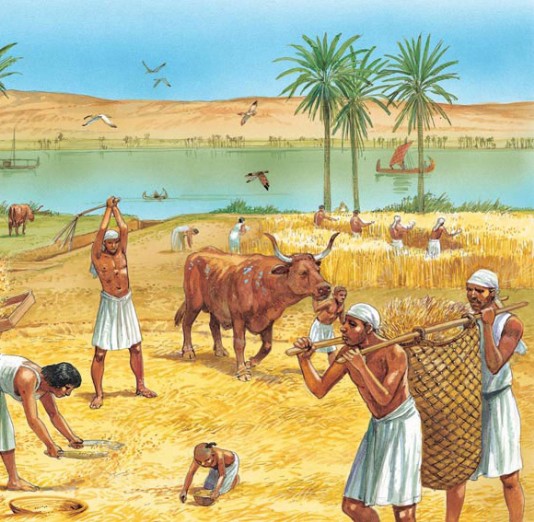 Farming in Ancient Egypt Image source
Farming in Ancient Egypt Image source
Ancient Greeks said that Egypt was the gift of the Nile. The Ancient Egyptians settled themselves on the narrow strip of alluvial soil along both banks of the Nile. This came about for two reasons: excellent agricultural soil in the thin fertile zone next to the river. Beyond this was barren land and rugged cliffs, followed by arid desert. The Nile is the biggest river in Africa and is the result of the joining of three rivers from Sudan, Uganda and Ethiopia. It starts in south (Upper) Egypt and ends at the country's northern border with the Mediterranean Sea (Lower Egypt). This separation of the country into two regions stems from ancient times. It also reflects the distinctly different higher ground and narrower river valleys in the south, from the flat flood plains of the delta in the north by the sea.The Nile River is considered to be the longest river in the world at 6,853 km.
Since before written history, people have built their homes in towns and cities developed along the banks of the Nile, but it wasn't always this way. The earliest inhabitants of this region were Stone-Age hunter-gatherers who roamed an immense area rich in wildlife, which is now a desert. With radical changes in climate, rain became less abundant and these people gradually replaced their nomadic culture with the settled life of agriculturalists. They settled along the banks of the Nile River and grew crops such as wheat and barley. They also farmed with animals. The Egyptians used the Nile for drinking water, irrigation, fishing, mud and reeds and they sailed around the Nileto transport goods.
‘We are content with our Black land … the heartland is with us’. - A Pharaoh’s inscription on a wall in the Temple of Karnak in Thebes, referring to Egyptian appreciation of the fertile soil. Ancient Greeks said that Egypt was the gift of the Nile. The Ancient Egyptians settled themselves on the narrow strip of alluvial soil along both banks of the Nile. This came about for two reasons: excellent agricultural soil in the thin fertile zone next to the river. Beyond this was barren land and rugged cliffs, followed by arid desert. The Sahara desert, the Nile River and the abundance of rock greatly influenced where and how the ancient Egyptians settled and built their civilization.
In its lower (northern) part, the Nile River splits itself many times and spills into the Mediterranean Sea across a huge delta plain. To the east another natural boundary, The Red Sea, extends roughly parallel to the Nile. Because of these two seas, the Egyptians were the only people of the ancient world to be able to control both western and eastern foreign trade.
It is due to the Nile River that the ancient Egyptians were able to develop their civilization. The Nile River brought water and rich fertile soil that the Egyptians used to grow crops in. The Egyptians knew which time of year the Nile River would flood, bringing its gift of rich soil. The Egyptians depended on the Nile River to flood otherwise they could not grow their crops and there would be a famine. Egyptian daily life revolved around the Nile River for planting and harvesting crops. The Nile flooded the area for about three months and then it had time to empty out into the Mediterranean Sea and return back to its normal size and flow.
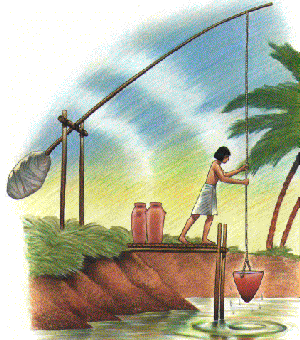 A Shaduf used in ancient Egypt Image source
A Shaduf used in ancient Egypt Image source
 An illustration of an Archimedean screw Image source
An illustration of an Archimedean screw Image source
Since the Nile flooded its banks every year, the Egyptians built their houses close together on high land and farmers were forced to move further inland. Farmers built canals and created an irrigation system to water their crops.They used ‘shadufs’, a hand-operated device for lifting water from the Nile River into buckets, which they then poured into the irrigation ditches. Farmers also made use of an ‘Archimedean screw’ which was used to lift water from a low lying body of water into irrigation trenches. Once the bottom of the screw-thread was lowered into the water the farmer turned the handle and as the bottom end of the tube turned, it scooped up a volume of water that travelled up the spiral screw within an enclosed tube; until it finally poured out from the top to feed the irrigation systems.
Pharaohs would have beautiful leisure boats built for them to travel up and down the Nile for pleasure and relaxation. The Nile River was also important for transportation and trade.
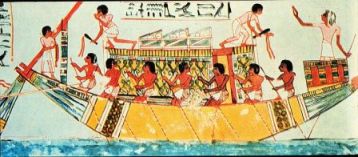 An Egyptian boat Image source
An Egyptian boat Image source
The Nile River also played an important role in the economic, political and spiritual life of Egyptians. The river provided Egypt with trade routes in both the east and the west. Small boats were first built from the papyrus plant which grew on the banks of the Nile River, and was used for fishing and short trips. As the Egyptians skills developed, they began building bigger boats from wood which were able to transport cattle, stone, wood and people along the Nile. In its lower (northern) part, the Nile River splits itself many times and spills into the Mediterranean Sea across a huge delta plain. To the east another natural boundary, the Red Sea, extends roughly parallel to the Nile. Because of these two seas, the Egyptians were the only people of the ancient world to be able to control both western and eastern foreign trade. Due to this trading system, water buffaloes and camels were transported to Egypt from Asia and Persia during the 17th century. Camels were used for ploughing and carrying water from the river Nile, a process which was very important both for the people and their livestock.
The Nile River also played in a role in the spiritual life of the Egyptian. It was believed to be the gateway from life to death and the afterlife. The rise and fall of the Nile waters led the ancient Egyptians to view cycles of birth, death and re-birth. The east coast of the Nile was thought to be a representation of birth or life, and the west coast of the Nile was thought to symbolise death. This originates from the movement of the sun, which rises (is born) in the east and sets (dies) in the west. That is why all the tombs and pyramids are seen on the west bank of the River Nile. The god of the Nile is Hapi, who was known as the bringer of water and fertility. Osiris, god of the afterlife is also associated with the Nile as he was killed on its river bank. The Nile influenced many religious acts in ancient Egypt, which stemmed from its depiction of the afterlife, such as the preservation of mummies and the construction of the Great Pyramids that were built with its waters.
The Nile River, due to its importance for Egyptian life, was present in their religion. Egyptians believed that the Nile River was the river way that was taken from life to death and then to enter the afterlife. The east was looked upon as the place of growth and birth (the sun rising) and the west was part of death (the sun setting). The Sun god Ra would travel in a boat from birth, through life, through death in the underworld and then to be reborn each day. Egyptians based their calendar on the three cycles of the Nile River. Each season lasted four months, each month thirty days.
 Journey of Re traveling through the Underworld in his solar barque Image source
Journey of Re traveling through the Underworld in his solar barque Image source
The tomb of Tutankhamen ↵
Of all the pharaohs of ancient Egypt, Tutankhamen is the most famous. This is due to the wealth of artefacts found in his tomb, which was "discovered" in 1922 by British archaeologist Howard Carter, some 3000 years after Tutankhamen's death. The quantity of objects shocked archaeologists who had until then not found a tomb still containing treasures.
King Tuts tomb is located in the Valley of Kings, situated at the west bank of the Nile. What makes the discovery of his tomb so significant is the fact that for thousands of years the tomb of King Tut remained safe from grave robbers. However, it is believed that thieves had broken into Tutankhamun’s tomb shortly after his burial, but the robbers were soon found and the tomb was resealed. The size of King Tuts tomb was small in comparison to other pharaohs, which has led some to believe that his death was unexpected and thus his burial was rushed by his successor AY. Following his death, King Tut’s rule had been ignored by the pharaohs who had succeeded him and his tomb held little importance. Workmen building tombs of future pharaohs built their huts over the young king’s place of burial. The building, along with flooding in the area meant that within a few generations the entrance to King Tut’s tomb had been clogged with stone debris and forgotten.
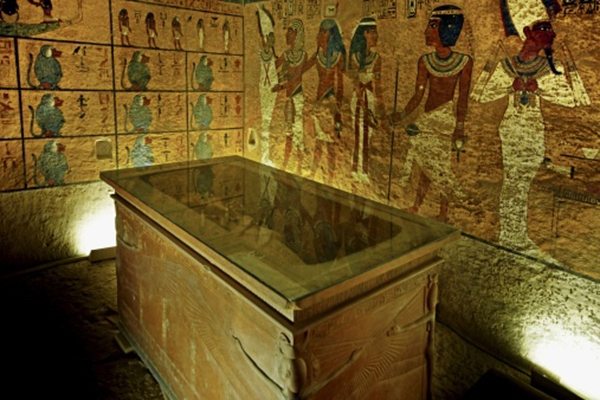 Tutankhamen's sarcophagus Image source
Tutankhamen's sarcophagus Image source
Tutankhamun or “King Tut” is the most famous Egyptian pharaoh. Tutankhamun means ‘the living image of Amun”. He is well known because his burial tomb is one of the few that was discovered intact. It was very common for tomb raiders to steal the treasures that were buried with the pharaohs. Luckily, the tomb raiders didn’t locate King Tut’s tomb. We were then able to learn about the culture and people of ancient Egypt all from studying King Tut’s tomb and treasures.
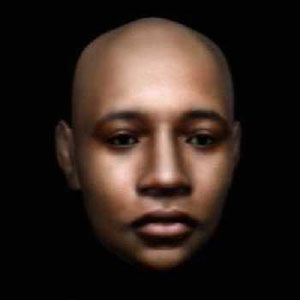 What king tut would have looked like? Image source
What king tut would have looked like? Image source
Tut lived around 1343 to 1323 BC, he was only ten years old when he became a pharaoh and he earned his nickname of the ‘boy king’. King Tut’s father was the pharaoh Akhenaten. Akhenaten tried to change Egypt’s religion by removing all the old gods and replacing them with one god called Aten. This change was unpopular and when Akhenaten died the Egyptian people destroyed all traces of his reign.
King Tut relocated the city back to Thebes and rebuilt some of the temples for the gods. His hope was to restore popularity of the pharaoh and try to fix the damage that his father had done.
King Tut died at the young age of 19 and the cause of his death still remains a mystery today. Tutankhamun was buried in a tomb in the Valley of the Kings. In 1922, British archaeologist Howard Carter discovered the burial tomb of King Tut. Ancient Egyptians believed that when a person died they would enter the ‘afterlife’ where they would live in the same way that they did when they were alive. That is why Egyptians would bury everything they would need in the afterlife with them. The burial tomb of King Tut was piled with possessions: beds, chariots, games, art work, walking sticks, weapons and even food. Pharaohs had the most highly crafted items, many were made of gold, imported wood, inlaid gems and ivory.
The most fascinating item found was the stone sarcophagus containing three coffins, one inside the other, with a final coffin made of gold. When the lid of the third coffin was raised, King Tut's royal mummy was revealed, preserved for more than 3,000 years. It took Carter 17 years to fully excavate King Tut’s tomb.
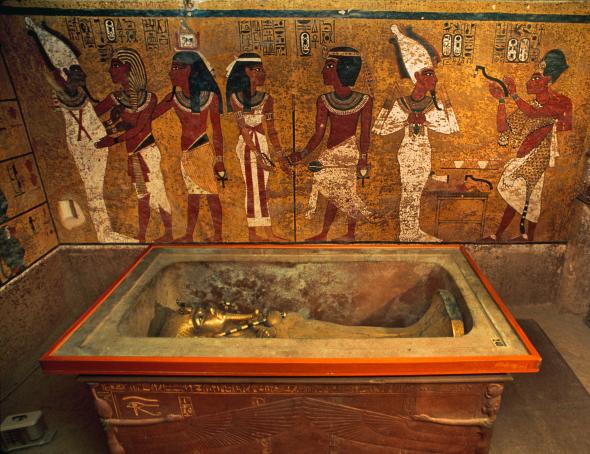 A gilded coffin rests inside a sarcophagus of carved quartzite in the original burial chamber Image source
A gilded coffin rests inside a sarcophagus of carved quartzite in the original burial chamber Image source
Way of life in ancient Egypt ↵
Social structure in ancient Egypt
Ancient Egyptians are the inventors of another feature of civilization still existing today - the complete dictator! Social and industrial conditions were determined, through priests and scribes, by the inflexible rule of omnipotent rulers. All of Egypt was subjugated under one ruler, the Pharaoh, who was God, king and high priest all rolled into one. The Pharaoh, screening much of his work and status in a kind of confusing mystery, centralized socio-economic power and control efficiently and ruthlessly, owns all the land. It is as if the triangular shape of pyramids themselves, show the hierarchy and control of one over many.
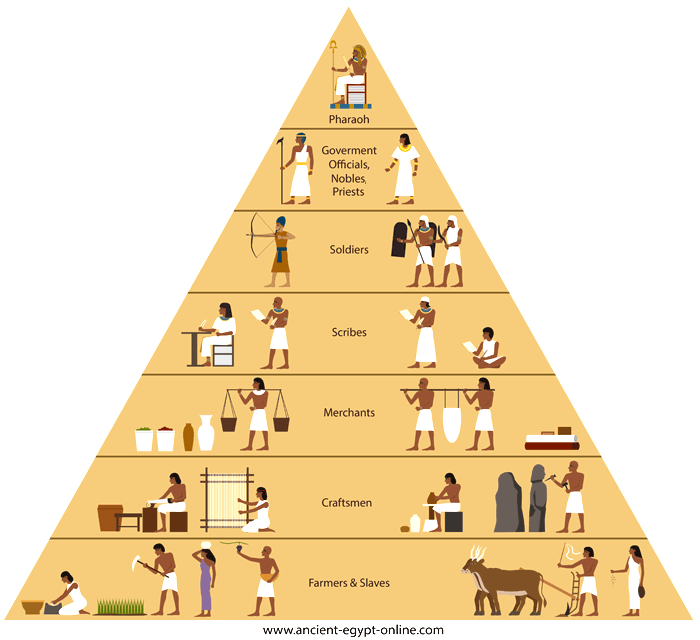 Under the Pharaoh on the social pyramid sat the vizier (advisor). The vizier was the chief minister in charge of managing the taxes, building projects and government records that were kept by scribes. Next came the priests of the temples and the various nobles who held government jobs. Nobles were quite wealthy as they kept a part of the tax normally given to the pharaoh as well as some of the tributes that were given by the people to the gods. Army officials and scribes were on the next level down on the social pyramid. The soldiers fought in the armies during wartime, but in peacetime many supervised the peasants, enslaved people and farmers. They were also part of the building process of palaces, pyramids and other structures. Image source
Under the Pharaoh on the social pyramid sat the vizier (advisor). The vizier was the chief minister in charge of managing the taxes, building projects and government records that were kept by scribes. Next came the priests of the temples and the various nobles who held government jobs. Nobles were quite wealthy as they kept a part of the tax normally given to the pharaoh as well as some of the tributes that were given by the people to the gods. Army officials and scribes were on the next level down on the social pyramid. The soldiers fought in the armies during wartime, but in peacetime many supervised the peasants, enslaved people and farmers. They were also part of the building process of palaces, pyramids and other structures. Image source
Under the Pharaoh on the social pyramid sat the vizier (advisor). The vizier was the chief minister in charge of managing the taxes, building projects and government records that were kept by scribes. Next came the priests of the temples and the various nobles who held government jobs. Nobles were quite wealthy as they kept a part of the tax normally given to the pharaoh as well as some of the tributes that were given by the people to the gods. Army officials and scribes were on the next level down on the social pyramid. The soldiers fought in the armies during wartime, but in peacetime many supervised the peasants, enslaved people and farmers. They were also part of the building process of palaces, pyramids and other structures.
The royal household, priesthood and civil service administered the state under a system of nepotism - the children of the pharaohs and bureaucrats were exempt from manual work and succeeded to their parent's position automatically. The civil service improved mathematics and writing (on clay and papyrus). These skills they kept to themselves and so maintained control. In this way planning and ideas became separate from doing and making. (Hellman: 1994)
Using the food surplus generated by a favourable climate and a large labourforce of enforced labour, the Pharaohs financed huge pyramids that eventually would contain their embalmed bodies and worldly riches for the after-life. These were built in summer during flood time by a very large staff of trained craftsmen and an army of peasant, slave and prisoners of war labourers. This religious obsession of the upper classes with the preservation of the body after death, led to the pyramid tomb standing as a symbol of the terrible majesty of the Pharaoh’s power.
The kings of ancient Egypt were known as 'pharaoh', a name given to them by the Hebrews while enslaved, and derived from the Egyptian word 'per-aa', meaning 'great house'.(Fletcher:1963).
Beliefs and religion
Ancient Egyptian religion remained mostly unchanged for many thousands of years, apart from a very short time of belief in one god during the Amarna period under King Akhenaten. Their culture changed little over this time. Although the Egyptians claimed to be monotheistic, in practise they were polytheistic.
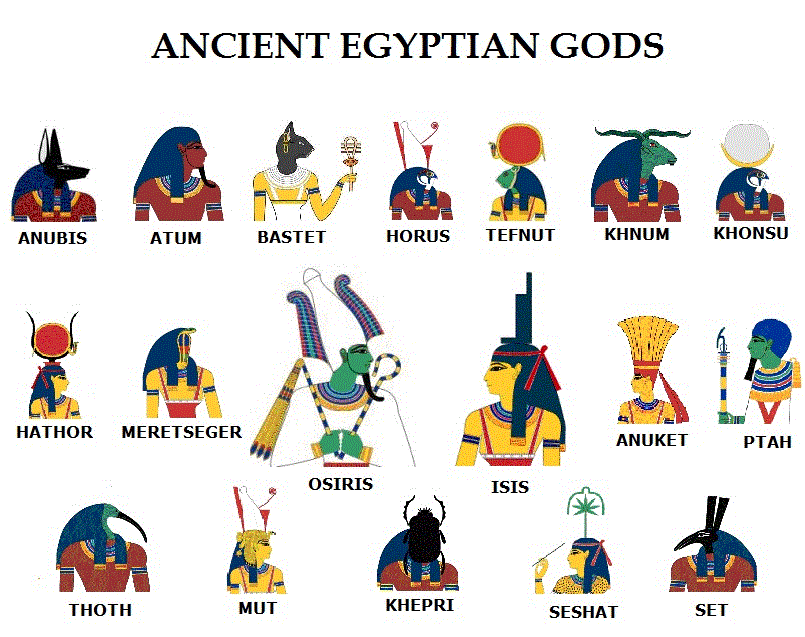 Ancient Egyptian gods Image source
Ancient Egyptian gods Image source
Religion was organized by a very powerful, well-educated priesthood with unlimited authority under the Pharaoh. The king was God on earth in the form of man, and no distinction was made between God and king. It was because of this that the ancient Egyptian belief system created and supported the political and social hierarchy.
Egyptians strongly believed in an after-life, but only the wealthy could afford the expensive and labour-intensive preparations for this after-life. Kings and powerful nobility could, and this led to the creation of the monuments of ancient Egypt, like the pyramids that many of us have seen in pictures.
Religion in Egypt evolved over centuries. This created and supported the political and social hierarchy. In Egyptian society religion was significant for growth of the civilization, as it fostered a shared understanding and shared values. Egyptians believed in the after-life. They believed that everyone possessed a soul that would live on after death. In their belief, after death, ordinary people would go to the world of Osiris (afterlife) while only Pharaohs would go to the land of Ra, the sun god. This is why Paraohs bodies were prepared in special way and buried in pyramids.
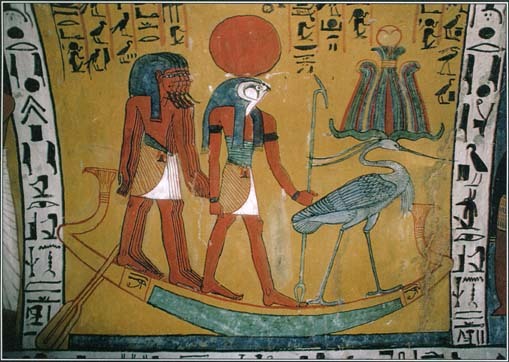 The Egyptian Sun god Ra Image source
The Egyptian Sun god Ra Image source
Egyptians had thousands of gods, but certain gods such as the sun god Ra, were held in greater esteem than others. He was usually shown in human form with a falcon head crowned with the sun disc encircled by the sacred cobra. Many gods were linked to special animals and were depicted to possess an animal head. These gods were greatly feared by the people of Egypt. It was believed that whoever displeased the gods would face a great punishment such as sickness, starvation, poor harvest or a defeat in battle.
Prior to the development of the concept of god, powers that controlled natural phenomena were seen as magical entities. Magical power was usually demonstrated through the hieroglyph of a sceptre, with gods that took animal forms. For example, there was Heket, the goddess of childbirth who had the head of a frog; Tefnut, the goddess of moisture and rain, had the head of a lioness; and Anubis, the god of mummification, had the head of a jackal. The sceptre can be seen throughout ancient Egyptian history as a symbol of divine power.
The next stage of religious worship saw Egyptians conceive God in a more personalised form. This phase was known as a mythical phase where gods were depicted as having human bodies and temples were built in major cities to worship local gods. During the New kingdom, 1100 B.C to 1600 B.C, these temples honoured a triad of gods based on the pattern established by the mythical family of Osiris, Isis and Horus.
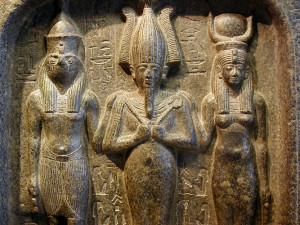 A carving of the mythical family of Osiris, Isis and Horus Image source
A carving of the mythical family of Osiris, Isis and Horus Image source
The Pharaoh was god on earth in the form of man and no distinction was made between God and king. A powerful and well educated priesthood had unlimited authority under the pharaoh and organised religion. It was only the wealthy, namely kings and powerful nobility who could afford the expensive and labour-intensive preparations for the after-life, which would allow them to enter the land of the sun go.,This they believed would allow them to keep power.
Egyptian religion continued to develop and influence other societies, such as Greece and Rome, which conquered Egypt in the 600 B.C and 30 B.C. Ancient pagan religions eventually faded and were replaced by monotheistic religions. Today the majority of the Egyptian population is Muslim, while a small minority are Jews and Christians.
Mummies
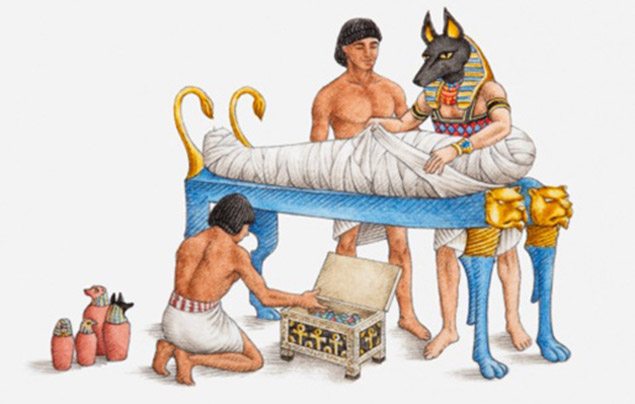 mummification Image source
mummification Image source
Ancient Egyptians believed that when the pharaoh died, he would enter the land of the sun god, while part of his spirit (known as “ka”) would remain with his body. To properly care for his spirit, the corpse was embalmed in a special way, this is known as mummification. Initially the dead were buried in small pits in the desert; however, the heat dehydrated the bodies and created lifelike mummies. They then buried the bodies in coffins, but found that lack of sand and heat from the desert caused the bodies to decay. Centuries later, the Egyptians had managed to create a method of preserving the bodies in a way that they would remain lifelike, by embalming the bodies and wrapping them in strips of linen.
The process of mummification lasted for approximately 70 days. This process included removing the brain through the nose with a hook and taking out all the internal organs, and only leaving the heart inside the body. The body would then be covered in salt for approximately 70 days and then wrapped from head to toe in bandages. Once the pharaoh’s body had been turned into a ‘mummy’ it was placed in a coffin and buried in a vault in a pyramid along with the pharaoh’s treasures, such as food, water, weapons and a boat needed in the afterlife. The pharaohs' names were written in hieroglyphics on their tombs, as it was believed that if someone’s name was remembered then he or she would survive in the afterlife.
Pharaohs
The king was known as a pharaoh. He was the most powerful person in ancient Egypt. The pharaoh was the political and religious leader of the ancient Egyptian people.
The king or queen was known as a pharaoh, the most powerful person in ancient Egypt. The pharaoh was the political and religious leader of the ancient Egyptian people, holding the titles: 'Lord of the Two Lands' and 'High Priest of Every Temple'. The title ‘Lord of the Two Lands’ meant that the Pharaoh was the ruler of Upper and Lower Egypt and the rightful owner of all its land. He was also able to make laws, collect taxes and defend Egypt against foreigners. Being the ‘High Priest of Every Temple’ meant the pharaoh represented the gods on earth, thus performing rituals and temples to honour the gods. Those conquered during a battle had to recognise the Egyptian pharaoh as their ruler and offer him the finest and most valuable goods from their land.
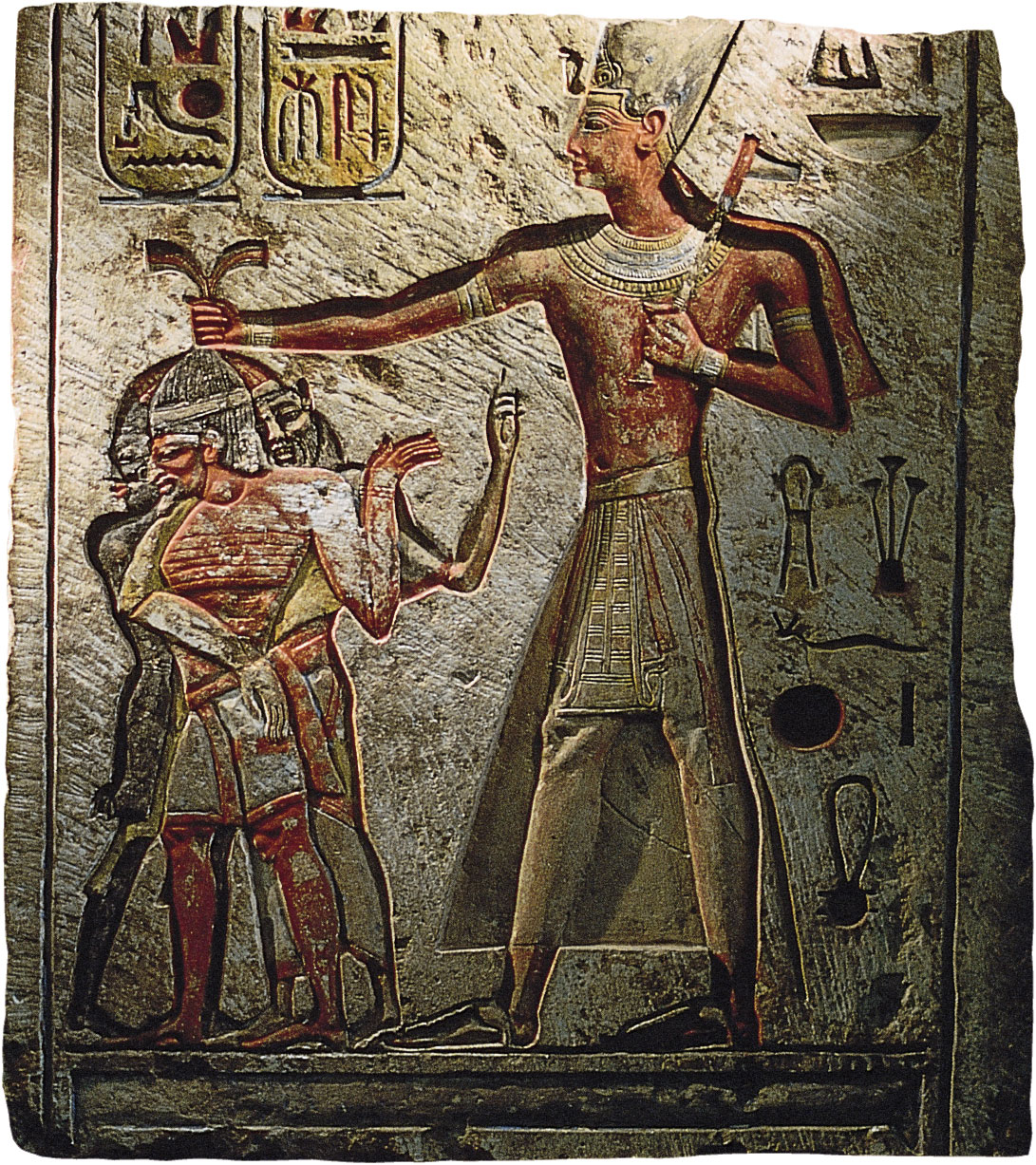 Ramses II Image source
Ramses II Image source
Pharaohs were admired by the people of Egypt and seen as living gods who were the rightful owners of the land of Egypt and its people. Pharaohs were believed to have been chosen by the gods to serve as mediators between themselves and the people on earth, being neither human nor Divine, but lying somewhere in-between. Because of this, it was in everyone’s interest to keep the king’s majesty intact even after his death, when he was believed to become Osiris, god of the dead. The new pharaoh, in turn, became Horus, the falcon-god who served as protector of the sun-god, Ra.
The eldest son of a royal family was usually given the role of pharaoh; however, there are also instances of female Pharaohs such as Cleopatra VII Philopator, who was the last pharaoh to rule ancient Egypt from 51-30 B.C. Kufu; the second pharaoh of the fourth dynasty reigned from 2589 B.C to 2566 B.C. He is most famous for building the Great Pyramid of Giza, one of the Seven Wonders of the World. Hatshepsut who came to power in 1498 B.C had the longest reign of any other woman in the Egyptian dynasty, being in power until 1483 B.C. Akhenaten ruled from 1379 B.C until1334 B.C. and is remembered for his religious revolution. Akhenaten attempted to establish a monotheistic religion through the sole worship of the Sun God Aten. Ramses II, Egypt’s pharaoh from 1279 B.C to 1212 B.C. is regarded as one of the most powerful leaders of the Egyptian empire. He defeated Hittites at the battle of Kadesh in 1274 B.C and went on to live a long life, dying at the age of 92.
Sphinx, pyramids and temples
The Sphinx of Giza (also known as the Guardian of the Horizon) is a symbol that has represented the essence of Egypt for thousands of years.
Archaeologists have discovered 35 major pyramids and 40 smaller ones. Pyramids were huge structures with storage rooms, courtyards and secret passageways. The pyramids were constructed from massive blocks of stone and originally built as tombs for the bodies of dead pharaohs. The Pharaoh was buried alongside material possessions, which would be needed in the afterlife, such as gold vessels, furniture and food. The riches were not only meant to provide for the pharaohs, but also for their relatives, officials and priests who were buried near them. The construction of pyramids were labour intensive, stones from the quarries had to be cut and moved without wheels, using human or animal power. It took approximately 20 years for 5000 workers and enslaved people to build a pyramid.
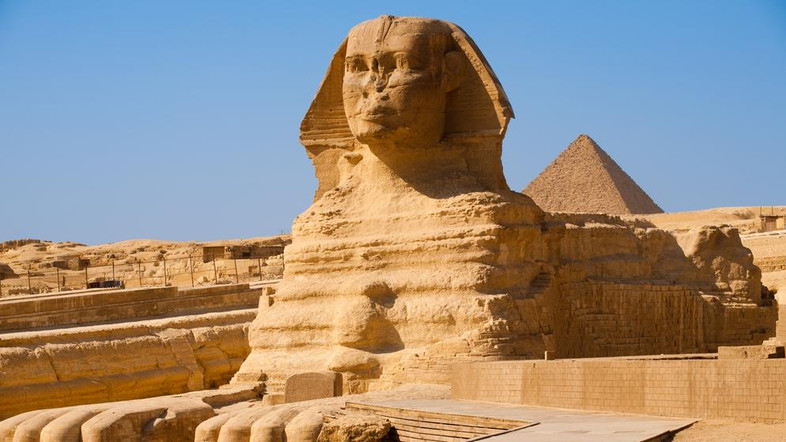 Sphinx Image source
Sphinx Image source
Carved from the mould of a natural rock in the Giza plateau, the Sphinx is truly a mysterious marvel from the days of ancient Egypt. With the body of a lion and the head of a king or god, the Sphinx has come to symbolize strength and wisdom.
The Ancient Egyptians built pyramids as tombs for their pharaohs and queens. Pyramids were huge structures with storage rooms, courtyards and secret passageways.
Temples were a place of worship and learning in ancient Egypt. In religious customs the temple was seen as ‘the horizon’ of a god, the point at which a god came into creation. This meant that every temple was built to honour a specific god. Egyptian people went to the temple to pray and women often brought food and goods to the temple as offerings to the gods. The temples were run by the chief priests who were rich and powerful. Children attended school in the temple, visitors from other towns would also stay there and grain was stored in the temple and shared with those who needed it. The Temple of Hatshepsut, known as ‘the most magnificent of the magnificent’ by the ancient Egyptians, was built in worship of the sun god.
 The temple of Hatshepsut Image source
The temple of Hatshepsut Image source
When the ancient Egyptians started trading, they needed to keep a record of what they bought or sold. This led to the development of their alphabet. At first they used picture writing called hieroglyphics, where each picture stood for a sound. Scribes primarily did the writing, as most of the population could not write.
Hieroglyphics can be seen carved into or painted on walls inside temples and pyramids. Initially this was the only form of writing, however, Egyptians invented the first form of paper known as papyrus in 3000 BC. This enabled the scribes to write down things and create the first written documents.Papyrus refers to a thin paper-like material made by cutting reed collected from the Nile River into thin strips and placing them over each other in a ‘criss-cross’ manner. This was then covered with a cloth and hammered straight, creating a surface for writing.
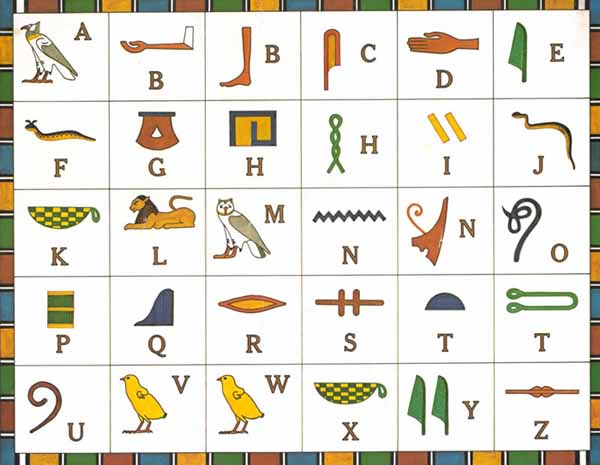 Ancient Egyptian Writing and Hieroglyphs Image source
Ancient Egyptian Writing and Hieroglyphs Image source
The Rosetta Stone is considered to be the most famous slab of stone in history. In 1798 Napoleon Bonaparte sent a team of historians, scientists and draughtsmen along with his army. They discovered the slab, which was found and kept by a troop of French soldiers stationed at Fort Julien in the town of Rosetta in the Nile Delta.The stone contained text inscribed in Greek, demotic and hieroglyphics. The slab of rock is 188cm high, 77cm wide and 30cm deep and weighs three quarters of a tonne.
Previously scholars assumed that hieroglyphics was simply a form of picture writing and needed a literal translation of the images. However, this changed after the discovery of the Rosetta Stone. Since the stone contained the same text, which appeared to be a decree from the general council of Egyptian priests issued in 196 B.C and written in 3 different languages, it acted as a key for translation. The Greek translation allowed for the discovery that each hieroglyphic character represented a distinct sound, similarly to letters in the English alphabet. Unfortunately, the ancient Egyptian language had not been spoken for at least 8 centuries, which meant that it was not possible to know the sound of the Egyptian words.
A note on hieroglyphics:
- Each alphabetic sign represents a single sound
- The syllables are a representation of two or three letters
- When a picture is followed by an upward stroke it means that it represents a whole object or a whole word.
- When a picture of a roll of papyrus that was sealed was used, it indicated that only writing and not pictures could express the meaning of a word.
- It is not possible to precisely match hieroglyphics with the English alphabet, however, historians have managed to come up with a simplified translation of English letters and Egyptian hieroglyphs.
| A | an Egyptian vulture | P | asquare stool |
| B | a foot | Q | a symbol for the slope of a hill |
| C | a basket with handle | R | a mouth |
| D | a hand | S | a piece of linen folded over |
| E | a reed | T | a bun |
| F | a horned viper (an Egyptian snake) | U | a quail chick (which stands for the sound 'U') |
| G | a jar-stand | V | a horned viper |
| H | a reed shelter | W | a quail chick |
| I | a reed | X | a basket and folded linen |
| K | the basket with the handle again (because hard 'C' is like 'K') | Z | a door bolt |
| L | a lion | CH | a hobble |
| M | an owl | KH | a ball of string |
| N | a zigzag symbol for water | O | a lasso |
Mathematics and astronomy
The ancient Egyptians possessed one of the earliest forms of mathematics that inspired all mathematical traditions that followed. They developed a system of numbers, using symbols for the numbers 1 and 10.
Little is known about Egypt’s mathematical achievements. However, by analysing their exploits in engineering and astronomy, it can be determined that they possessed an advanced understanding of numbers. The oldest mathematical text from ancient Egypt discovered thus far is the Moscow Papyrus, which dates from the Egyptian Middle Kingdom around 2000 B.C. - 1800 B.C.
The ancient Egyptian numbering system was developed around 3000 B.C. The Egyptians created a system of numbers using stroke symbols for the numbers 1 to 9. The system uses a base of 10 and no concept of decimal numbers existed. Numbers were written from the highest number to the lowest number and read from top to bottom when more than one row of numbers existed
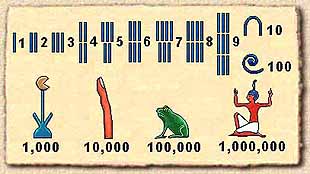 The Egyptian number system Image source
The Egyptian number system Image source
In ancient Egypt astronomy was sacred and greatly influenced culture. Egyptian astronomy developed as a result of attempting to predict the annual flooding of the Nile River. They discovered that when Sirius, the brightest star, rose in front of the sun on the morning of the summer solstice, the annual flood would occur. This event was marked as Day 1 of their calendar year. The Egyptians understood that the year had 365 days, and 12 months with 30 days in each month. They included 5 "feast days" at the end of each year to celebrate the birthdays of certain gods. Egyptians also used astronomy to tell time. They made use of sundials, which divided the days into 24 hours, although the length of these hours was not fixed, ensuring that day and night both consisted of twelve hours, whatever the time of year.
Hieroglyphic numbers 1 is shown by a single stroke. 10 is shown by a drawing of a hobble for cattle. 100 is represented by a coil of rope. 1,000 a drawing of a lotus plant. 10,000 is represented by a finger. 100,000 is a tadpole or frog 1,000,000 figure of a god with arms raised above his head.
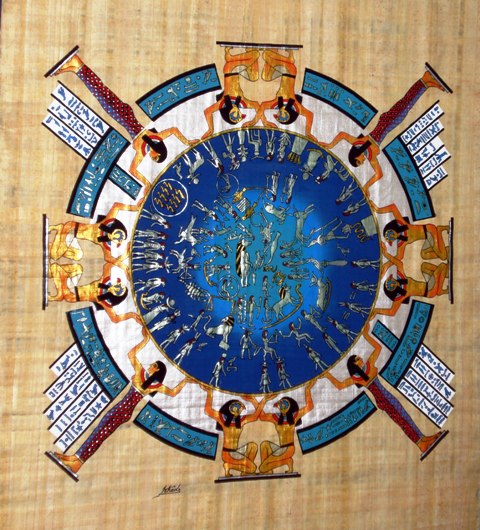 An ancient Egyptian calendar Image source
An ancient Egyptian calendar Image source
The stars were important for the construction of pyramids and temples, which were positioned in relation to the stars. Tools such as a ‘merkhet’ was used in planning the design and placement of a pyramid or temple. The merkhet was a small wooden plank with a hole at one end. Ancient astronomers would look through the hole and angle the device until their target star was aligned accurately.
Ancient Egyptian astronomy was also a religious tradition. The Egyptians had no true understanding of the universe, so many myths were created as explanations for astronomical events. Certain gods were seen in the constellations and others were represented by actual astronomical bodies. The constellation Orion, for instance, represented Osiris, who was the god of death, rebirth and the afterlife.The sun was represented by multiple Gods. When the sun rose in the morning it was known as Horus, the reborn child of Osiris and Isis, God and Goddess of the afterlife. The hot, mid-day sun was known as the much more powerful sun God, Ra. And the evening sun was the creator God, Atum, the "finisher of the world" who put to rest all other sun Gods, then died each day at sunset.
Medicine and physician
The ancient Egyptians had a great deal of knowledge of healing herbs and repairing physical injuries. Evidence shows that ancient Egyptian doctors also performed eye-surgery and practised dentistry. They extracted teeth, drained abscesses and made false teeth. The Egyptian physicians knew how to stitch a wound. Much of the Egyptian knowledge of the body came from their practise of embalming the dead.
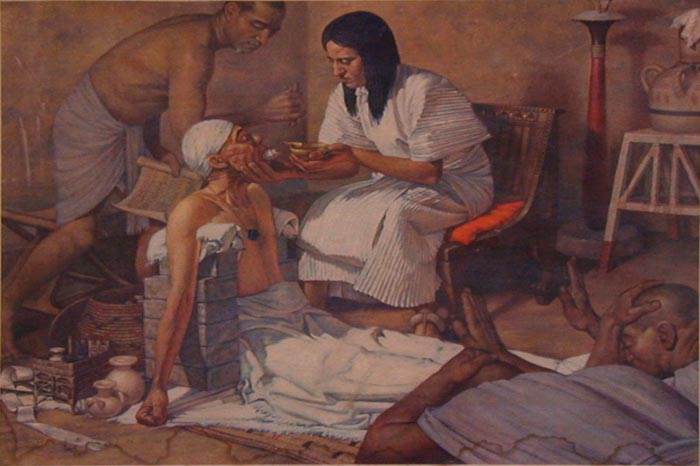 Ancient Egyptian Medicine Image source
Ancient Egyptian Medicine Image source
From the Stone Age to the Islamic period, Egyptian doctors were considered the best in the western world. However, it should be noted that during this period their knowledge around disease and cure was not that advanced and many Egyptian doctors believed evil spirits were the cause of ailments. Cures included concocted drinks and praying to Sekhmet, the goddess of healing. They did, however, also use effective medicinal treatments such as laxatives, setting broken arms and legs and massaging aching legs and calves.
Ancient Egyptian Medicine
The spread of Egypt’s knowledge ↵
Ancient Egyptians were amongst the first to record stories, love poetry and dramas. The Greeks also benefited from and were influenced by Egyptian sculpture and architecture. Their understanding of astronomy was very advanced and this knowledge was passed onto the generations that followed.
Egypt gave the world:
- The Art of Writing
- Paper, pen, ink and inkpot
- Literature of astrology, metallurgy, weaving and cooking
- Science - Calendar
- Mathematics and Geometry
- Medical Science
- Art and architecture – Pyramid, Temples and sculptures
- ostal Service
- Historiography – recording their own history
- Agriculture and Irrigation
- Systems of Administration
